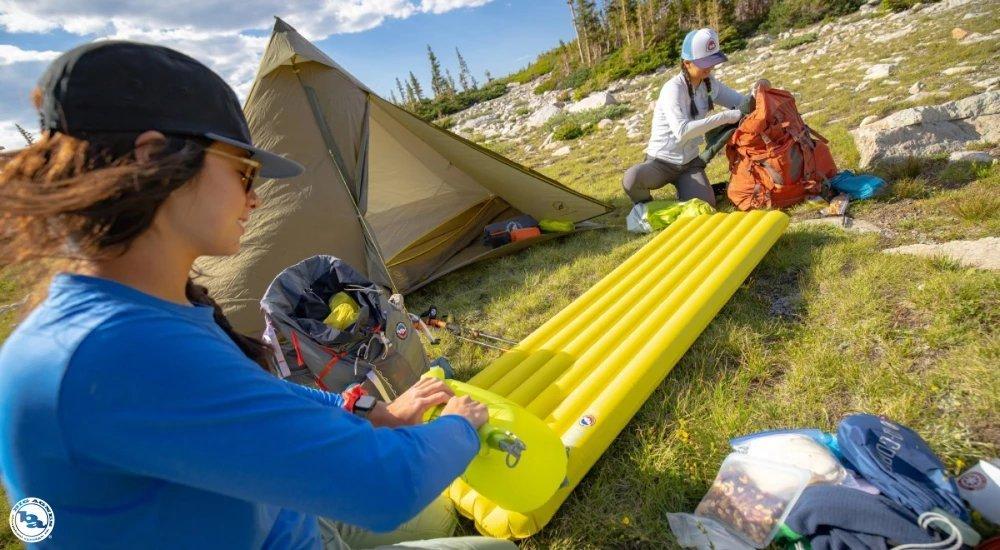Backpacking Checklist: What Gear to Pack

Backpacking is a great way to spend lots of time outdoors and exploring. Journeying into the deep backcountry and spending the night outdoors requires a slightly different set up than your day hiking essentials, however. Although each backpacking trip requires gear depending on the weather and terrain, there are several backpacking essentials you want to be sure to have. These items include the basics like safety, shelter, water, and food to be sure you’re safe on the trails. Whether you’re planning on backpacking for a weekend or a week, our Experts walk you through the top essentials to start your backpacking checklist!
1. Backpacking Pack
Your backpacking pack is one of the most important pieces of backpacking gear because it holds everything you need for the trail and setting up camp. As you’re putting on the miles, comfort is key, especially if you’re a beginner at backpacking. When choosing a backpacking pack there are three important factors: capacity, quality, and fit.
2. A Complete First Aid Kit
The next backpacking essential is a complete first aid kit. You can start with a pre-assembled first aid kit and customize it to best fit the needs of your group. In addition to basic first aid necessities such as bandages and ointments, it’s a good idea to have the following:
✔ A headlamp or flashlight with extra batteries
✔ A fire starter kit
✔ A knife or multi-tool
3. Navigation
When out in the backcountry, you won’t have reliable cell reception. It’s important to invest in a high-quality GPS device and learn how to use it properly before heading to the trails. Although this is great technology to use when on trials, they do rely on batteries, so it’s a good idea to have an area map too.
4. Hiking Clothing & Boots
When considering what to wear hiking, it really depends on the season and predicted weather conditions. As a rule, it’s important to look for clothing with sun protection to provide even better coverage. Keeping your feet dry and comfortable is a priority when backpacking, so consider choosing hiking boots that provide waterproof protection and a durable upper for maximum protection.
5. Backpacking Tent
When backpacking, you never know what kind of weather and wind you’ll encounter, and your backpacking tent provides the necessary protection. Look for a backpacking tent with the following features for the best protection and comfort:
-
A high bath-tub floor and waterproof sealed seams to keep you dry.
-
Additional attachment points to secure guylines for stability during high winds.
-
Add-on a matching footprint (sold separately from tent) to further waterproof your tent floor.
-
The right size of tent to provide enough room for sleeping and gear without being too heavy.
6. Sleeping Bag
Although bulky, sleeping bags are a backpacking essential. When choosing a backpacking sleeping bag, consider the insulation material, shape, and temperature rating. Most backpackers choose a mummy-shaped, down-insulated sleeping bag because it’s lightweight and efficiently traps in body heat. You may want to purchase a sleeping pad too as this makes it more comfortable as well as keeps you warmer through the night.
7. Water Bottle & Water Filtration System
One of the most important parts of any outdoor adventure is staying hydrated. To ensure you stay hydrated, make sure to start your trip with at least a full water bottle. If your backpacking pack includes a water reservoir, fill this up too. Water adds a lot of weight to your pack, so you’ll also need a method of treating water through a water filtration system to keep your load as light as possible. There are many types of water filtration systems including hand pump filters, gravity filters, or water bottles with filters, so you’ll have to find the type that works best for you.
8. Backpacking Food
With safety, shelter, and hydration covered, the last backpacking essential items include food and food preparation supplies. There are plenty of options when it comes to prepping your backpacking food, but it’s important to make sure you have a variety of healthy and nutritious meals and snacks. To minimize weight, backpackers typically pack dehydrated food.
9. Backpacking Camp Stove & Fuel
The type of meals you plan on packing influences which backpacking stove you need. Since space is so limited, many backpackers choose dehydrated meals that only require hot water to be boiled, making the Jetboil Flash Cooking System a popular choice.
When packing for your next trip, be sure to start with the backpacking essentials to maximize your fun and safety when on the trails. Whether it’s your first time backpacking or you’re experienced in the backcountry, it’s important to make your next adventure fun, safe and successful! If you have any additional questions about backpacking essentials and what gear to pack, don’t hesitate to reach out to one of our Experts at your local SCHEELS.
![[object Object]](https://res.cloudinary.com/dlwdq84ig/image/upload/w_3840,q_auto,c_scale/x1qgcm5jcooqwptm0kbq)